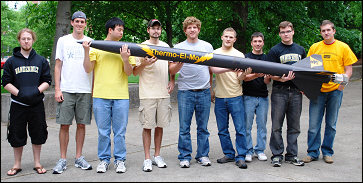Vanderbilt mechanical engineering students have designed a thermoelectric generator for aerospace applications that elicited strong accolades at the spring 2010 NASA-sponsored University Launch Initiative and won the Payload Design prize.
It has no moving parts and can convert some of the waste exhaust heat into usable electrical power.
 L-R: Cris Lioi, Ty Barringer, Travis Chan, James Board, Kyle Rosenstein, Sam Nackman, Nick Vass, Zach Smith and Sam McKnight displaying their ‘Thermo-Elmo’ (thermoelectric motor) rocket and payload that flew during the NASA USLI competition. |
The concept thermoelectric engine – built during the spring semester – uses commercial thermoelectric generators (TEG): solid state devices that can directly generate electric power across a temperature gradient. They work on the principle of the Seebeck effect, which states that free charge carrier transport results from thermal gradients.
Older Seebeck-based devices used bimetallic junctions and were bulky while more recent devices use bismuth telluride (Bi2Te3)-based semiconductor p-n junctions which can have thicknesses in the millimeter range, and can be engineered to have higher energy conversion efficiencies.
Professor A.V. Anilkumar, their adviser, said, “This concept of waste heat recovery is more applicable for long-duration aircraft flight, but one cannot pass up on an inexpensive test bed. Rocket flight offers vehicle speed and atmospheric access inexpensively, albeit for only a short time. The students jumped on the project and overcame several scientific challenges along the way unique to rocket flight. Every small savings count; even a 1-2% improvement in efficiency in airplane flight will mean substantial savings.”
The design team members were ME seniors Ty Barringer, James Board, Travis Chan, Sam McKnight, Sam Nackman, Kyle Rosenstein and Nick Vass.
Their design won strong accolades at the NASA-sponsored University Launch Initiative and won the Payload Design prize.
 Isometric view of the thermoelectric generator designed for rocket flight showing the direction of the exhaust jet and the radial thermal transport through the device. |
According to the NASA citation, the payload design award is awarded to the team with the most creative and innovative design, while maximizing safety and science value. “The Vanderbilt team designed and manufactured a payload in its own facility which used the heat from the motor’s exhaust plume to generate electrical power. The team went above and beyond what was required when presenting intricate details of the design, testing, and requirements for the payload at each review. While facing technical challenges beyond the scope of their curriculum, the team performed the necessary research to quantify and mitigate any problems faced in implementing their payload.”
“This project was a well thought out project because of the scientific knowledge that came from it along with the hands on skills it required,” said Design team leader Kyle Rosenstein. “Working through all the struggles taught everyone on the team a great deal that could not be learned otherwise. I personally learned a tremendous amount working on this project; everything from team management and machining skills to data acquisition and rocketry.
The maiden rocket test flight of the engine at the NASA USLI competition performed exceedingly well. The results prove that flight speeds are integral part of achieving high energy conversion efficiencies and that almost 5% of the heat passing through the generator can be directly converted to electrical power.
“This does not mean 5% of all the exhaust heat can be converted, as there will be issue of thrust interference, however, even if 1-2% of the exhaust heat can be converted to electrical power, it could mean substantial energy savings,” said Professor Anilkumar. “In the final analysis, incorporating such an engine on an actual airplane would require a cost-to-benefit analysis, but we feel it will come out positive especially if the device efficiencies improve.”
Rosenstein said, “I will forever in my mind think of this project as a winner and I think several members of the team would not hesitate to agree with me’ Adds team member James Board, “It was very rewarding to be able to work on a project that was both challenging and pertinent to modern problems facing the world.” Several of the team members are heading to graduate school in aerospace engineering.